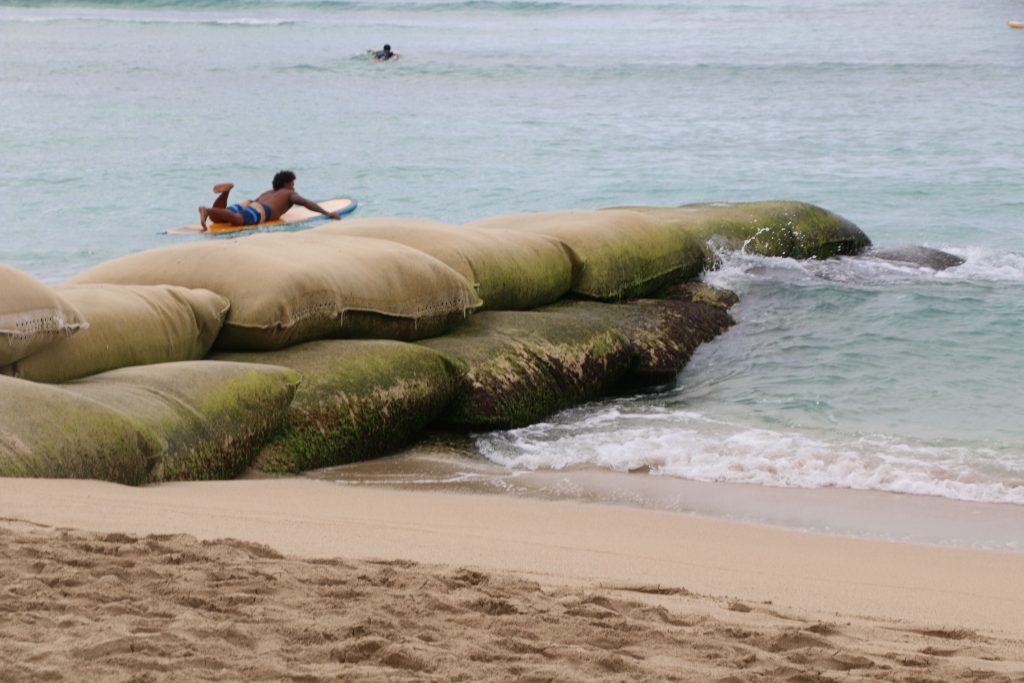02/19/20-TENDING A WORLD-FAMOUS BEACH – KŪHIO EROSION CONTROL PROJECT
Posted on Feb 19, 2020 in Main, Media, News Releases, OCCL, sliderDEPARTMENT OF LAND AND NATURAL RESOURCES
News Release
DAVID Y. IGE
|
SUZANNE D. CASE
|
TENDING A WORLD-FAMOUS BEACH – KŪHIO EROSION CONTROL PROJECT
Sandbag Groin Achieving Desired Result
To view video please click on photo or view at this link: https://vimeo.com/391747486
(Honolulu) –World-famous Waikīkī Beach is Hawaiʻi’s primary draw for tourists and the chief economic driver of Hawaiʻi’s economy. It has a fascinating history. Beginning in the 1930’s and continuing into the 1960’s one of the world’s most iconic beaches was built with stone and sand imported from different parts of the state.
Sam Lemmo knows beaches as the Administrator of the DLNR Office of Conservation and Coastal Lands (OCCL). When it comes to protecting and enhancing Waikīkī he puts it this way, “We rely on Waikīkī Beach, and we need to maintain it the same way you would with any public infrastructure.”
The latest beach improvement, the Kūhio Erosion Control Project, is performing well — so much so that, as Lemmo says, “we’re very, very happy.”
The new, short groin, running perpendicular to one of Waikīkī’s most popular beaches, is made up of eighty-three, 10,000-pound bags of sand. The groin stabilizes that part of the beach so that the old Waikīkī Tavern foundation is now buried allowing for safe pedestrian access to the water.
The ebb and flow of sand is a natural process, accelerated in recent history by sea level rise. Lemmo explains, “The ocean around Hawaiʻi has risen 9-10 inches over the past century. It has a profound impact on the viability of our beaches. We’re trying to get everyone comfortable with the notion that these beach restoration projects are critical in areas where beaches provide significant visitor and resident benefits If we are to maintain the viability of this tremendous asset in the face of climate change, we must continue to invest ourselves into its upkeep.”
But Lemmo adds that many natural beaches undergoing long term retreat due to rising seas will not be able to be repaired with modern engineering. The dynamics of intact natural coastal systems are very complex, and it would be unwise to initiate a beach engineering effort when it would be wiser to allow the shoreline to erode. His office and many other public and private interests are pursuing other options for natural beach resiliency, including encouraging development and people to move away from eroding shorelines. This allows a beach to recess inland like it would naturally in the absence of development.
Back at Kūhio Beach Lemmo points out, that as the state’s tourism center, Waikīkī accounts for close to half of the hotel rooms in Hawai‘i and generates more than one-third of the state’s gross domestic product.
“Waikiki is a very important place for us,” he said. “We’re just doing our part, trying to maintain one of the most famous beaches in the world. People come to Hawai‘i to visit our beaches and to enjoy our water, our coral reefs, and our mountains. This is just one component of an overall strategy to make sure we give our guests what they pay for…safe enjoyment of our resources and enjoyment of our Aloha.”
# # #
Media Contact:
Dan Dennison
Senior Communications Manager
(808) 587-0396
[email protected]
